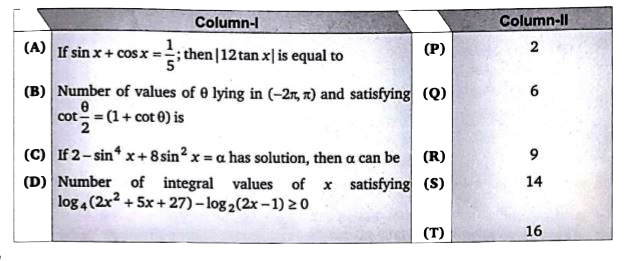sinθ+√3cosθ=6x−x2−11,0≤4θπ,x∈R, hold for no values of xandthη onevalueof x and two values of θ two values of x and two values of θ two point of values of (x,θ)
no values of x and θ
one value of x and two values of θ
two values of x and two values of θ
two pairs of values of (x,θ)
The correct Answer is:B, D
Step by step video, text & image solution for sintheta+sqrt(3)costheta=6x-x^2-11 ,0lt=4thetapi,x in R , hold for no values of xa n dtheta on ev a l u eof x and two values of theta two values of x and two values of theta two point of values of (x ,theta) by Maths experts to help you in doubts & scoring excellent marks in Class 12 exams.
Updated on:21/07/2023Topper's Solved these Questions
- TRIGONOMETRIC EQUATIONS Book:VK JAISWALChapter:TRIGONOMETRIC EQUATIONS Exercise:Exercise-3 : Comprehension Type Problems
Explore 3 Videos
- TRIGONOMETRIC EQUATIONS Book:VK JAISWALChapter:TRIGONOMETRIC EQUATIONS Exercise:Exercise-4 : Matching Type Problems
Explore 3 Videos
- TRIGONOMETRIC EQUATIONS Book:VK JAISWALChapter:TRIGONOMETRIC EQUATIONS Exercise:Exercise-5 : Subjective Type Problems
Explore 9 Videos
- STRAIGHT LINES Book:VK JAISWALChapter:STRAIGHT LINES Exercise:Exercise-5 : Subjective Type Problems
Explore 10 Videos
- VECTOR & 3DIMENSIONAL GEOMETRYBook:VK JAISWALChapter:VECTOR & 3DIMENSIONAL GEOMETRYExercise:Exercise-5 : Subjective Type Problems
Explore 16 Videos
Similar Questions
Consider f, g and h be three real valued function defined on R. Let f(x)=sin3x+cosx,g(x)=cos3x+sinx and h(x)=f2(x)+g2(x). Then,
The length of a longest interval in which the function g=h(x) is increasing, is
View Solution
View SolutionFind the number of solutions of the equations
(sinx−1)3+(cosx−1)3+(sinx)3=(2sinx+cosx−2)3 in [0,2π].
View SolutionIf the area of the quadrilateral ABCD whose vertices are A(1, 1), B(7, -3), C(12, 2) and D(7, 21) is Δ. Find the sum of the digits of Δ.
View SolutionA straight line L intersects perpendicularly both the lines :
x+22=y+63=z−34−10andx+64=y−7−3=z−7−2,
then the square of perpendicular distance of origin from L is
View Solutionsinθ+√3cosθ=6x−x2−11,0≤4θπ,x∈R, hold for no values of xandthη onevalueof x and two values of θ two values of x and two values of θ two point of values of (x,θ)
View SolutionIf sintheta=sqrt(3)costheta,-pi
View SolutionIf the equation (λ−1)x2+(λ+1)x+λ−1=0 has real roots then λ=sinθcosθ.cos3θsin3θ for (A) only one value of θ (B) for infinitely many values of θ (C) for no value of θ (D) of only two values of θ
View Solutionयदि x=aeθ(sinθ−cosθ) और y=aeθ(sinθ+cosθ) हो,तो बिंदु θ=π4 पर dydx का मान ज्ञात कीजिए
View SolutionFind the values of p if it satisfy, cosθ=x+px,x∈R for all real values of θ.
View SolutionIf sinθ=cosθ, then the value of 'θ' is ___.
View SolutionFind the value of dydx at θ=π4, if :
x=aeθ(sinθ−cosθ)andy=aeθ(sinθ+cosθ).
View Solutionsinθ+√3cosθ=6x−x2−11,0≤θ≤4πx∈R holds for :
View Solutionx=a(θ+sinθ),y=a(1−cosθ) হলে dydx-এর মান হবে -
View Solutionsinθ+√3cosθ=6x−x2−11,0≤θ≤4π,x∈R, (a) hold for no values of xandθ (b) one value of x and two values of θ (c) two values of x and two values of θ (d) two point of values of (x,θ)
View SolutionProve that the determinent ∣∣ ∣∣xsinθcosθ−sinθ−x1cosθ1x∣∣ ∣∣ is independent from value of θ
View Solution
